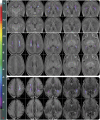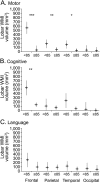Quantitative assessment of white matter injury in preterm neonates: Association with outcomes
- PMID: 28100727
- PMCID: PMC5317385
- DOI: 10.1212/WNL.0000000000003606
Quantitative assessment of white matter injury in preterm neonates: Association with outcomes
Abstract
Objective: To quantitatively assess white matter injury (WMI) volume and location in very preterm neonates, and to examine the association of lesion volume and location with 18-month neurodevelopmental outcomes.
Methods: Volume and location of WMI was quantified on MRI in 216 neonates (median gestational age 27.9 weeks) who had motor, cognitive, and language assessments at 18 months corrected age (CA). Neonates were scanned at 32.1 postmenstrual weeks (median) and 68 (31.5%) had WMI; of 66 survivors, 58 (87.9%) had MRI and 18-month outcomes. WMI was manually segmented and transformed into a common image space, accounting for intersubject anatomical variability. Probability maps describing the likelihood of a lesion predicting adverse 18-month outcomes were developed.
Results: WMI occurs in a characteristic topology, with most lesions occurring in the periventricular central region, followed by posterior and frontal regions. Irrespective of lesion location, greater WMI volumes predicted poor motor outcomes (p = 0.001). Lobar regional analysis revealed that greater WMI volumes in frontal, parietal, and temporal lobes have adverse motor outcomes (all, p < 0.05), but only frontal WMI volumes predicted adverse cognitive outcomes (p = 0.002). To account for lesion location and volume, voxel-wise odds ratio (OR) maps demonstrate that frontal lobe lesions predict adverse cognitive and language development, with maximum odds ratios (ORs) of 78.9 and 17.5, respectively, while adverse motor outcomes are predicted by widespread injury, with maximum OR of 63.8.
Conclusions: The predictive value of frontal lobe WMI volume highlights the importance of lesion location when considering the neurodevelopmental significance of WMI. Frontal lobe lesions are of particular concern.
© 2017 American Academy of Neurology.
Figures





Comment in
-
Toward quantitative MRI analysis: A smart approach to characterize neonatal white matter injury.Neurology. 2017 Feb 14;88(7):610-611. doi: 10.1212/WNL.0000000000003621. Epub 2017 Jan 18. Neurology. 2017. PMID: 28100729 No abstract available.
References
-
- Saigal S, Doyle LW. An overview of mortality and sequelae of preterm birth from infancy to adulthood. Lancet 2008;371:261–269. - PubMed
-
- Glass HC, Bonifacio SL, Chau V, et al. . Recurrent postnatal infections are associated with progressive white matter injury in premature infants. Pediatrics 2008;122:299–305. - PubMed
-
- Raybaud C, Ahmad T, Rastegar N, Shroff M, Al Nassar M. The premature brain: developmental and lesional anatomy. Neuroradiology 2013;55(suppl 2):23–40. - PubMed
MeSH terms
LinkOut - more resources
Full Text Sources
Other Literature Sources
Medical
